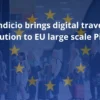Decentralized identity will improve the passenger experience at every step of the travel ribbon, creating new opportunities for airlines, airports, and the hospitality and tourism sectors
By Heather Dahl
For those of us who remember the pre-smartphone era of travel, with long lines and paper tickets, being able to get tickets and boarding passes and negotiate check in from a smartphone has been a transformational way to save time and alleviate stress.
But that was only a first step toward a seamless, digitized travel experience. A second, much bigger leap is now possible, thanks to a new method of using Digital Travel Credentials that was successfully showcased at the 2022 ICAO Trip Symposium in September.
Using technology developed with Indicio, SITA, the world’s leading IT provider for the air transport industry, demonstrated how passenger identity information can be ingested into privacy-preserving, tamper proof verifiable credentials based on the Digital Travel Credentials (DTC) standards set out by the International Civil Aviation Organization (ICAO) for creating a full digital equivalent to a paper passport.
A DTC verifiable credential means that passenger data can be verified as authentic instantly and repeatedly without complex integrations into databases, using third parties to manage verification, or relying on manual checking. With SITA and Indicio’s technology, any government entity can have the power to verify DTC verifiable credentials in a way that enables passenger data to become immediately actionable while preserving passenger privacy.
The verifiable credential solution created by SITA and Indicio will transform check in, boarding, border control—and all aspects of travel that require assured identity verification.
DTCs move digital identity beyond government use
The DTC verifiable credential from SITA and Indicio advances the adoption of automated, biometric, and self-service solutions. DTC verifiable credentials allow travelers to control their personal information in a way that can be digitally verified by both commercial and government entities.
Intended to be as widely accepted as existing passports and usable for purposes beyond the ticket counter, the DTC VC reduces friction at lines for the gate, border crossings, public transportation facilities like airports and cruise terminals, and hospitality sites such as amusement parks and hotels.
The ICAO standard for the DTC is structured as a phased approach, with three types of DTC. These types include the simplest and quickest way to create a digital version of an existing document (Type 1, holder derived via smartphone), a more enhanced and verified digital equivalent of the physical passport (Type 2, state derived via appointment), and a full virtual replacement for the passport (Type 3, state issued).
SITA demonstrated the first use of a Type 1 DTC in a verifiable credential.
DTCs lay a path to business growth
For those already established in the aviation and travel industry, the DTC provides a way to transform passenger experience by making travel seamless. This simplifies travel infrastructure while providing a next generation capacity to combat fraud and enhance data privacy and security.
The interoperable nature of verifiable credentials based on DTCs opens up new opportunities to develop experiences for “trusted” travelers, and to integrate with governments and other industries across different dimensions of travel, tourism, and transport without having to create complex direct integrations.
With immediately actionable data, companies, governments, and organizations of all kinds can reduce friction associated with manual verification of paper documents, improve customer experiences, and offer new services.
DTC verifiable credentials are a simple way to mitigate fraud, comply with data privacy regulations, and integrate with government, airline, and partner travel applications without direct database integrations.
The Digital Travel Credential’s time is now
Digital Travel Credential verifiable credentials can be integrated into existing systems in weeks rather than months. They provide a simplicity of mechanism that existing and alternative solutions lack. Built using open source and on open standards, and supported on both iOS and Android, the DTC verifiable credentials are a sustainable technology supported by a diverse and experienced developer community and a growing list of adoptions and implementations across multiple sectors.
Together with SITA, we see DTC verifiable credentials as providing the simplest, most effective, and robust way to advance the digital transformation of travel and significantly enhance the passenger experience. Our goal with SITA is to make it as easy as possible to enact DTC standards through a full, open source technical solution.
Learn more about the underlying technology of a Digital Travel Credential here.






